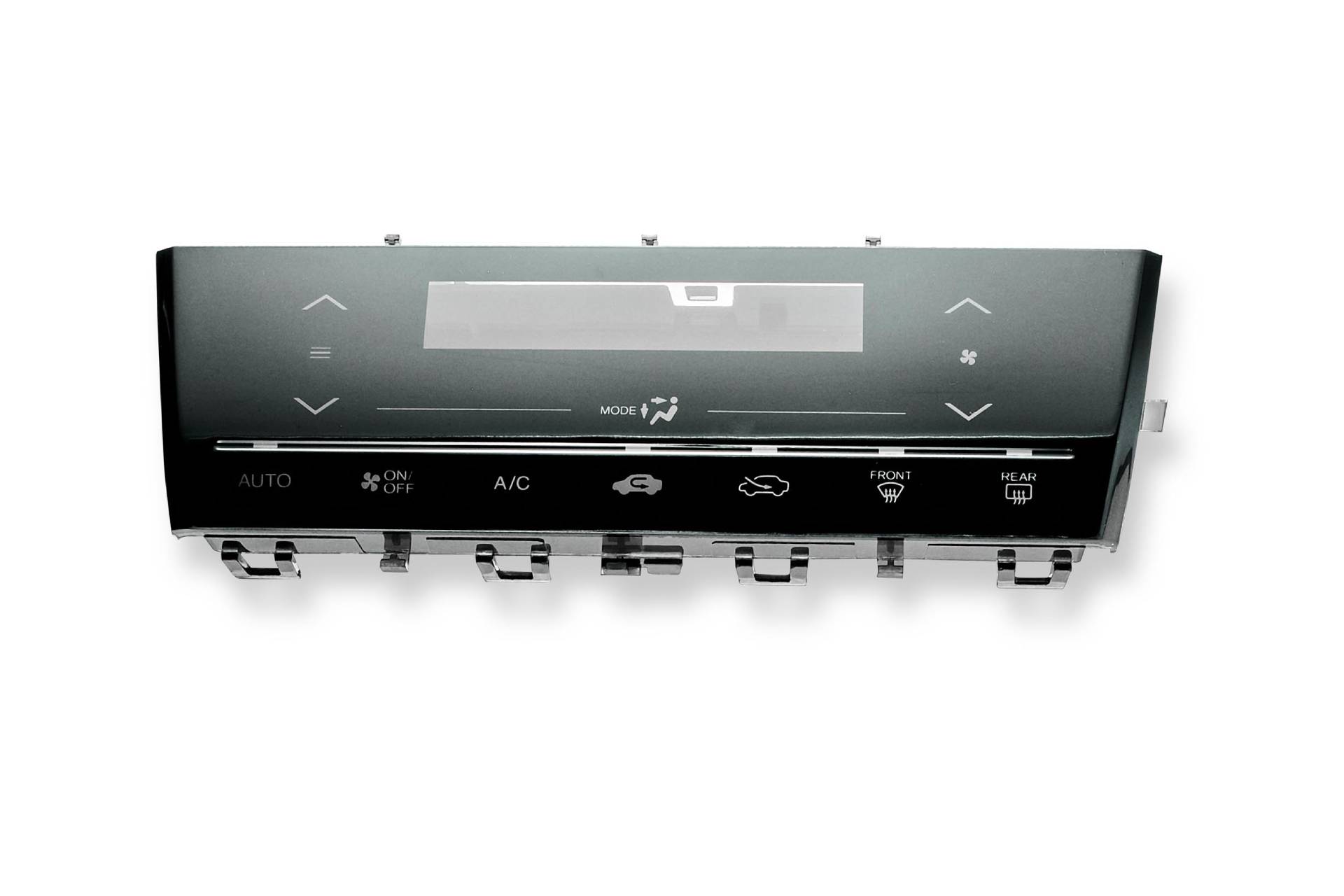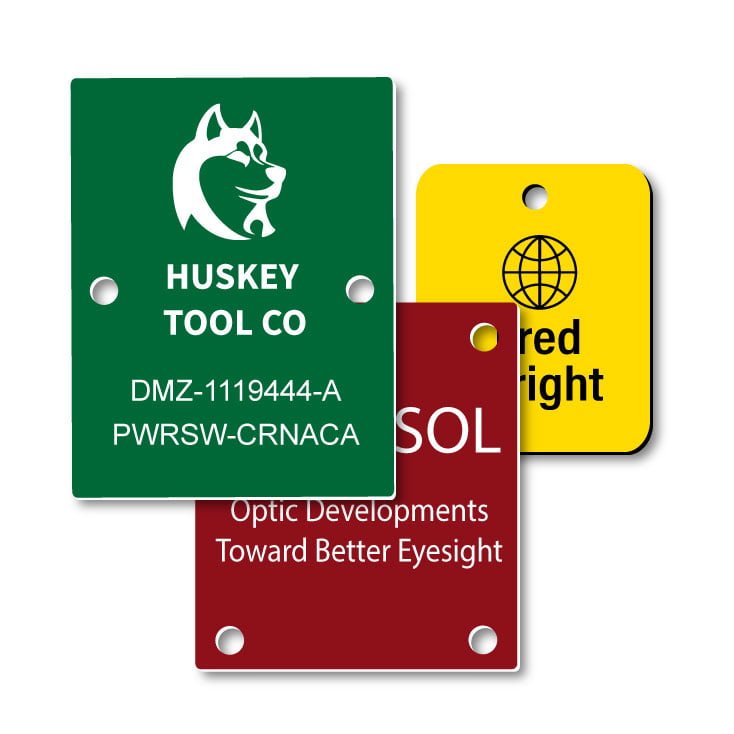Plastic Nameplates and OSHA Compliance: What You Should Know
Just How Plastic Nameplates Are Produced: A Comprehensive Overview to Their Production Refine
The manufacturing of plastic nameplates involves numerous exact steps, beginning from the choice of appropriate products to the last complements. Each phase is crucial, making sure the product satisfies specific demands for longevity and visual appeals. Different production strategies play a significant role in crafting these nameplates. Recognizing these procedures can clarify the intricacies behind what could feel like an easy product. What factors add to the high quality and personalization of these nameplates?
Comprehending Plastic Products Made Use Of for Nameplates

The Design Refine: From Idea to Model
The style procedure for plastic nameplates begins with a clear concept that overviews the overall development. Designers collaborate with customers to specify the purpose, style, and details needs of the nameplate. This initial phase includes conceptualizing sessions, mapping out concepts, and selecting colors and fonts that line up with branding goals.Once the principle is established, designers make use of computer-aided design (CAD) software to create in-depth electronic representations. These prototypes permit for visualization and changes before progressing. Feedback from stakeholders is indispensable throughout this stage, as it aids improve the layout to fulfill expectations.After wrapping up the digital prototype, a physical design might be produced, commonly through strategies like 3D printing. This concrete depiction allows further examination of looks and performance. In general, the style process is an essential step that lays the structure for the effective production of high-quality plastic nameplates.
Reducing and Forming the Plastic
In the cutting and forming phase of plastic nameplate manufacturing, the option of products plays an essential function in figuring out the last item's top quality and resilience (Plastic Nameplates). Various precision cutting methods, such as laser cutting and CNC machining, assurance that the plastic is shaped with accuracy and uniformity. This combination of cautious product choice and progressed reducing methods is vital for creating high-quality nameplates

Product Selection Process
Choosing the ideal product is vital for generating high-quality plastic nameplates. Numerous kinds of plastics are readily available, each offering distinct advantages and features. Common selections consist of acrylic, polycarbonate, and PVC. Polymer is favored for its quality and UV resistance, making it perfect for outdoor applications. Polycarbonate, known for its longevity and influence resistance, appropriates for environments that require boosted defense. PVC is frequently chosen for its cost-effectiveness and adaptability in layout. The selection procedure likewise considers elements such as surface area, color, and density finish, which can greatly affect the last appearance and performance of the nameplate. Ultimately, the selected material has to align with the intended use and aesthetic goals of the plastic nameplate.
Precision Trimming Methods
While picking the ideal material prepares, precision cutting strategies play a necessary duty fit the plastic nameplates right into their final types. Different methods, consisting of laser cutting, CNC milling, and pass away cutting, are utilized to achieve accuracy and consistency. Laser cutting utilizes focused light to produce elaborate layouts and clean sides, suitable for complicated patterns. CNC milling provides convenience by eliminating excess material with accuracy, suiting different densities and shapes. Die reducing, on the other hand, permits for mass production of uniform pieces, boosting performance. Each strategy is selected based upon the design specs and the preferred finish, guaranteeing that the end product fulfills quality requirements and consumer expectations while keeping toughness and visual charm.
Printing Techniques for Customization
Exactly how can manufacturers accomplish exact and lively layouts on plastic nameplates? The answer exists in different printing strategies customized for personalization. Digital printing has actually gotten popularity because of its capability to create high-resolution photos and detailed designs directly onto plastic surface areas. This approach enables quick turn-around times and marginal configuration costs, making it perfect for brief runs and individualized orders.Screen printing stays an additional commonly utilized strategy, particularly for larger quantities. It includes creating a pattern and applying layers of ink, causing rich shades and longevity. UV printing, which uses ultraviolet light to treat the ink, is also efficient, offering outstanding bond and resistance to fading.Additionally, pad printing offers flexibility for irregularly shaped nameplates, permitting thorough layouts on difficult surface areas. These printing methods allow manufacturers to fulfill varied client needs while guaranteeing top quality and longevity in their plastic nameplate products.
Surface Area Treatments and Finishing Options

Quality Assurance Actions in Production
Ensuring the highest criteria of quality assurance throughout the production of plastic nameplates is vital for preserving item stability and consumer complete satisfaction. Makers implement strenuous assessment procedures at different stages of the production procedure. Raw products undergo comprehensive testing to verify they satisfy requirements for toughness and color consistency. During the molding stage, automated systems keep track of specifications such as temperature level and pressure to stop defects.In addition, visual assessments are conducted to recognize any surface imperfections or misalignments. As soon as the nameplates are generated, they are subjected to practical examinations, visit their website including attachment tests for printed components and anxiety tests for toughness. Quality control teams often utilize statistical sampling techniques to analyze sets, ensuring that any type of discrepancies from requirements are immediately addressed. This in-depth method not only enhances item top quality however also cultivates count on with customers, attesting the maker's commitment to excellence in every nameplate produced.
Packaging and Distribution of Finished Nameplates
The packaging and distribution of ended up plastic nameplates are critical actions in ensuring they get to consumers in ideal condition. Various packaging products are picked to secure the nameplates during transportation, while shipping methods are very carefully picked based upon performance and cost-effectiveness. In addition, reliable storage remedies are executed to keep high quality till the nameplates are provided.
Packaging Materials Used
Choosing proper packaging products is crucial to assure their security during transportation when dispersing ended up plastic nameplates. Generally used materials consist of bubble cover, foam extra padding, and cardboard boxes, all created to cushion the nameplates versus influences and shocks. Bubble wrap provides a flexible obstacle, while foam padding guarantees that nameplates stay securely in place, reducing the risk of scratches or damage. In addition, tough cardboard boxes are utilized to contain the nameplates, providing architectural assistance click for more and defense from exterior aspects. Tags might be related to suggest handling directions or breakable materials, better enhancing safety and security during transport. On the whole, making use of high-quality packaging materials substantially adds to the integrity and discussion of the completed plastic nameplates upon arrival at their destination.
Shipping Approaches Employed
Efficient circulation of completed plastic nameplates counts on different delivery techniques that guarantee prompt and safe distribution. Business frequently utilize messenger services, freight shipping, and post offices, depending upon the size, weight, and destination of the plans. For local shipments, courier solutions supply fast transit, making sure nameplates get to clients promptly. For larger orders, freight delivery is chosen, making use of trucks or shipping containers to deliver bulk quantities effectively. Postal solutions function as a cost-efficient alternative for smaller sized shipments, particularly for residential deliveries. All delivery approaches focus on protective packaging to protect against damage during transportation. Tracking systems are also utilized to check deliveries, offering clients with real-time updates and reassurance concerning the status of their orders.
Storage Solutions Implemented

Regularly Asked Questions
What Sorts Of Services Commonly Use Plastic Nameplates?
Plastic nameplates are typically used by numerous businesses, consisting of offices, medical facilities, colleges, and factories. These nameplates serve necessary functions such as identification, info look at here display screen, and branding, adding to business performance and professional appearance across varied environments.
The length of time Does the Entire Production Refine Take?
The manufacturing process period differs based upon complexity and amount, typically varying from a few days to several weeks. Elements influencing this timeline consist of style approval, material availability, and production techniques employed by the firm.
Can Plastic Nameplates Be Recycled After Usage?
Plastic nameplates can be reused, provided they are made from recyclable products. The availability of recycling programs and local guidelines might influence their recyclability. Proper disposal techniques are necessary to guarantee efficient recycling.
What Are the Ecological Effects of Plastic Nameplate Manufacturing?
The ecological influences of plastic nameplate production consist of carbon emissions, source deficiency, and contamination from producing procedures. Plastic Nameplates. Furthermore, improper disposal adds to plastic waste, negatively impacting communities and wild animals, highlighting the demand for sustainable practices
Exist Any Safety Worries With Plastic Nameplates?
Safety problems relating to plastic nameplates largely entail prospective chemical exposure during manufacturing and the danger of products breaking down with time, which might bring about hazardous compounds being launched, impacting both human health and the setting. While various products can be made use of for nameplates, plastic continues to be a popular option due to its flexibility and resilience. In the cutting and forming stage of plastic nameplate production, the choice of products plays an essential function in establishing the final item's quality and longevity. Selecting the appropriate material is crucial for creating premium plastic nameplates. While picking the suitable product lays the groundwork, accuracy reducing techniques play a crucial duty in shaping the plastic nameplates into their final kinds. When distributing finished plastic nameplates, choosing proper packaging materials is crucial to guarantee their security throughout transportation.